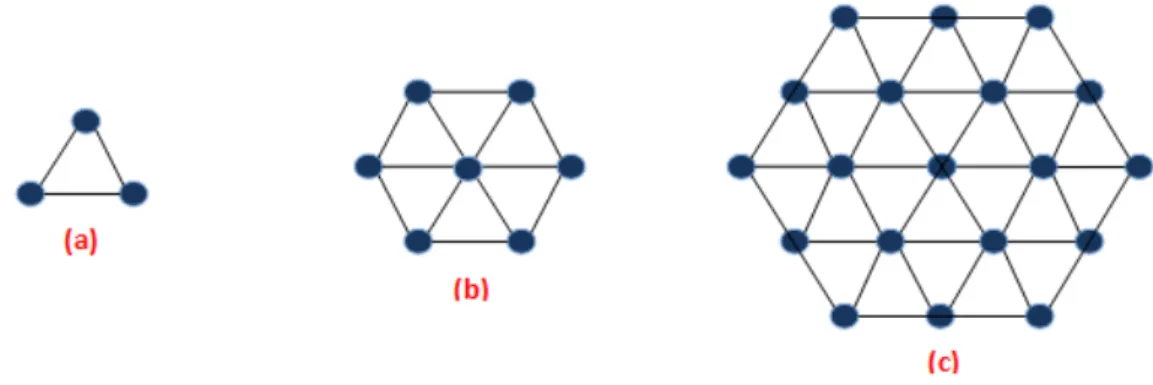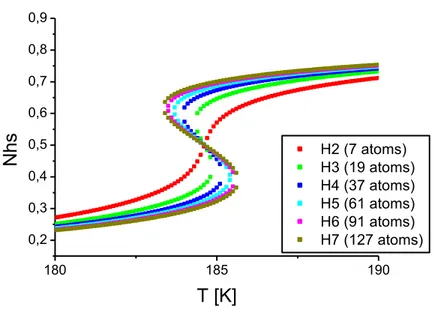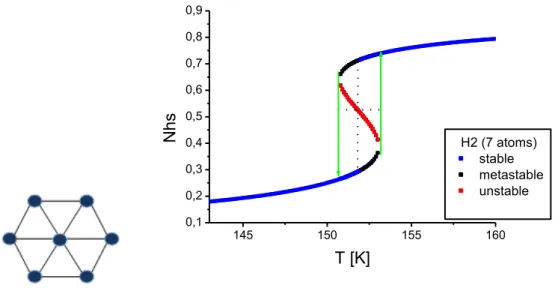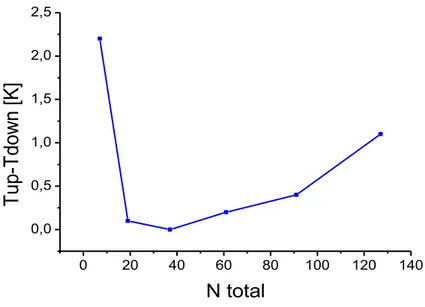HAL Id: insu-01966074
https://hal-insu.archives-ouvertes.fr/insu-01966074
Submitted on 27 Dec 2018HAL is a multi-disciplinary open access
archive for the deposit and dissemination of sci-entific research documents, whether they are pub-lished or not. The documents may come from teaching and research institutions in France or abroad, or from public or private research centers.
L’archive ouverte pluridisciplinaire HAL, est destinée au dépôt et à la diffusion de documents scientifiques de niveau recherche, publiés ou non, émanant des établissements d’enseignement et de recherche français ou étrangers, des laboratoires publics ou privés.
Ising-like model applied to a triangular lattice of 2D
spin-crossover nanoparticles: evidence of a re-entrant
phase transition
J. Linares, I. Sahbani, F. Desvoix, Pierre-Richard Dahoo, K. Boukheddaden
To cite this version:
J. Linares, I. Sahbani, F. Desvoix, Pierre-Richard Dahoo, K. Boukheddaden. Ising-like model ap-plied to a triangular lattice of 2D spin-crossover nanoparticles: evidence of a re-entrant phase transi-tion. Journal of Physics: Conference Series, IOP Publishing, 2018, 1141, pp.012073. �10.1088/1742-6596/1141/1/012073�. �insu-01966074�
PAPER • OPEN ACCESS
Ising-like model applied to a triangular lattice of 2D spin-crossover
nanoparticles: evidence of a re-entrant phase transition
To cite this article: J. Linares et al 2018 J. Phys.: Conf. Ser. 1141 012073
View the article online for updates and enhancements.
Content from this work may be used under the terms of theCreative Commons Attribution 3.0 licence. Any further distribution of this work must maintain attribution to the author(s) and the title of the work, journal citation and DOI.
Published under licence by IOP Publishing Ltd
International Conference on Mathematical Modelling in Physical Sciences IOP Conf. Series: Journal of Physics: Conf. Series 1141 (2018) 012073
IOP Publishing doi:10.1088/1742-6596/1141/1/012073
1
Ising-like model
applied
to a triangular lattice of 2D
spin-crossover nanoparticles: evidence of a re-entrant phase
transition
J.Linares1,2., I.Sahbani3., F. Desvoix1, P.R.Dahoo3, K.Boukheddaden1
1GEMAC, Université de Versailles Saint-Quentin-en-Yvelines, 45 Av. des Etats-Unis,
CNRS-UMR 8635, 78035 Versailles Cedex, France
2 Departamento de Ciencias, Sección Física, Pontificia Universidad Católica del Perú,
Apartado 1761 - Lima, Peru
3LATMOS, Université de Versailles-Saint-Quentin-en-Yvelines,
CNRS-UPMC-UVSQ (UMR 8190), 11 boulevard d'Alembert, 78280 Guyancourt, France
Abstract. We consider a 2D spin crossover (SCO) nanoparticles configuration under the
influence of an external environment. Each nanoparticle is at the vertex of a triangular lattice leading to hexagonal-shaped systems. Each molecule located in the bulk is then connected to six nearest-neighbours (nn) while those situated at the surface have three or four nn.
Adapting the entropic sampling Monte Carlo method, using three parameters: nHS (the total high spin fraction), s (the correlation: the sum of nn interactions the molecules) and nsHS (the high-spin fraction at the surface), we determined the density of macrostates D(nHS, nsHS ,s) by scanning the full spin configurations. This information is then used to analyse the thermal behaviour of the system taking into account for the short- (J) and long-range (G) interactions as well for the interactions (L) between the molecules at the surface and the matrix (environment). The present contribution is devoted to the investigations of the required physical conditions which allow this triangular 2D lattice to exhibit a re-entrant phase transition, in particular when the size of the nanoparticles is reduced.
1. Introduction
Reducing the size of microelectronic components, increasing their performance and guaranteeing reasonable prices is one of the challenges for the future. That’s why in recent years, there has been a growing interest in the field of spin-crossover (SCO) solids [1-4]. The spin-crossover materials have the advantage of being able to switch from a low spin state called LS to a high spin state called HS under the effect of an external physical disturbance: temperature, pressure, light, magnetic fields [5-9]. This switching can be accompanied by physical changes such as the color for the appearance, conductivity for the property and volume for the size.
This work aims to study the spin-crossover of Fe (II) compounds located in an octahedral ligand field under the effect of temperature which is one of the most effective physical factors used to induce the transition from one state to another. The spin transition compounds can display a different kinds of magnetic behavior with a variation of temperature (progressive or abrupt, two or more stages, complete or incomplete, with or without hysteresis). In this contribution we are particularly interested
2
in studying the influence of the interaction between the surface molecules and the surroundings on the spin transition accompanied by a thermal hysteresis cycle for triangular 2D spin-crossover nanoparticles from numerical simulations based on the Ising-like model.
2. Model:
In order to predict the behavior of the material with temperature variation, numerical simulations were performed based on the Ising-like model.
Ising-Like model proposed first by Wajnsflasz and Pick[10] and then by Bousseksou et al [11] uses a fictitious spin operator σ which can take the value +1 or -1 to specify respectively the HS and LS state with degeneracies gHS for the HS and gLS for the LS state. Linares et al [12-13] proposed an
explicit extension of this model by introducing short- and long-range interactions, termed J and G respectively in the model. Another important term that will be introduced is the interaction (L) between the surface molecules and the surroundings [14-16]. The addition of the L parameter is based on the fact that surface molecules have specific properties.
As a result, the Hamiltonian is written in the following form:
! =
∆$%&' () *+
∑
-
. /.01
− 3 ∑
4.,67-
.-
6− 8 ∑
.01/-
.< - > −; ∑
<.01-
%(1)
Where N and M are respectively the total and the superficial number of different sites for the atoms. This Hamiltonian, as expressed, makes it possible to simulate the material behavior in an environment characterized by its interactions not only in the core of the material, but also at the edge.
In this expression σ presents a fictitious spin operator which can take the value -1 (the low spin state) and the value +1 (the high spin state), Δ is the gap between the low spin state and the high spin state, g = gHS / gLS is the ratio between the respective degeneracies gHS and gLS of the HS and LS
states.
The following definitions of macroscopic parameters are highlighted as they will be useful in the description of different thermodynamic properties:
= = ∑/.01-.
(2) > = ∑4.,67-.-6
(3)
? = ∑<%01-′%
(4)
Where σ'k represents the molecules on the edge, m and c are respectively the total and superficial
"magnetizations" and s is the sum of two spin correlations. The Hamiltonian can be written as: ! = B∆$%&' () *
+ − 8 < - >C = − 3> − ;? (5)
The fictitious magnetic average is given by: < - >=
∑FGDEF
EHI J(LEMENE)PQRS$T&UI ($VLE$WME$XNE)Y
∑FGEHIJ(LEMENE)PQRS$T&UI ($VLE$WME$XNE)Y
(6)
Where N is the total number of atoms, d<m,s,c> is the density of states that represents the
number of degenerate configurations (configurations with the same m, c and s values), NL the
different macro-configurations <m,s,c> and h is expressed as:
ℎ = − B∆$%&' () *
International Conference on Mathematical Modelling in Physical Sciences IOP Conf. Series: Journal of Physics: Conf. Series 1141 (2018) 012073
IOP Publishing doi:10.1088/1742-6596/1141/1/012073
3
In this case we are dealing with a self-consistent equation (< - >= [(< - >)) which can be solved numerically by the bisection technique. At the end we can write the solution as nHS, the
high-spin fraction:
\]^= 1_ 〈a〉+
(8)
To obtain the density of the states c(=.>.?.) in Equation (6) we have adapted the entropic
sampling Monte Carlo method [13, 17], using three parameters: nHS (the total high spin fraction), s (the
correlation: the sum of nn interactions the molecules) and ns
HS (the high-spin fraction at the surface).
3. Results and discussions:
We consider nanoparticles of a triangular lattice leading to hexagonal-shaped systems, see Fig 1 Each molecule located in the bulk has then six nearest-neighbours (nn) while those situated at the surface have three or four nn.
Figure 1 :Schematic representation of hexagonal-shaped systems: (a) Triangular case, (b) Hexagonal lattice with 7 atoms (designed H2 in this article), (c) Hexagonal lattice with 19 atoms (H3)
We have studied six cases, with 7, 19, 37, 61, 91 and 127 molecules with quite different ratio "t" number of molecules at the surface versus the total number, as it is shown in table 1. This "t" ratio is important to highlight the influence of the environment, reflected by the "L" interaction term, over the molecules at the surface.
Table I: Different size of hexagonal-shaped systems.
N = total number of atoms t= number at the surface atoms/N H2 7 0.85 H3 19 0.63 H4 37 0.48 H5 61 0.39 H6 91 0.32 H7 127 0.28
In our simulation we use typical values of spin crossover compounds for the Δ parameter (the energy gap between the fundamental energy level of the HS and the LS states) and the g= gHS/gLS
4
First we consider the case where the there is no interaction between the molecules at the surface and the environment (it means L=0).
Figure 2: The simulated thermal behavior of the total high spin (HS) fraction, Nhs(T), for different
system sizes from H2 (7 atoms) to H7 (127 atoms). The computational parameters are: Δ/kB = 1200 K,
G/kB = 170K, J/kB = 15 K, L/kB = 0 K, ln(g) = 6.5.
As it is shown in Fig. 2 the thermal hysteresis decrease as the number (and so the size) decreases until it disappears. This behavior is explained by the fact that the Curie (or the order-disorder) temperature designed by TOD decreases when the size of the molecules decreases whereas the
transition temperature designed by Teq is fixed (in our case Teq= 184.6 K for the parameters chosen
for the simulation). The value of the transition temperature is obtained from the following equation: def = ∆
%&()*
(9)
The first-order phase transition takes place when the condition TOD>Teq is satisfied.
We study now the case corresponding to the interaction between the molecules at the
surface and their immediate environment, L/k
B= 125 K. Our results are shown in Fig 3.
180 185 190 0,2 0,3 0,4 0,5 0,6 0,7 0,8 0,9
Nhs
T [K]
H2 (7 atoms) H3 (19 atoms) H4 (37 atoms) H5 (61 atoms) H6 (91 atoms) H7 (127 atoms)International Conference on Mathematical Modelling in Physical Sciences IOP Conf. Series: Journal of Physics: Conf. Series 1141 (2018) 012073
IOP Publishing doi:10.1088/1742-6596/1141/1/012073 5
We take the case H2 (7 atoms) to better analyze the result
In the zone bounded by the two green arrows, there appears a thermal hysteresis, the interactions are then strong enough leading to a 1st order phase transition with a hysteresis cycle. The hysteresis consists of three main zones where the free energy F of the system has extrema corresponding to stable, metastable and unstable solutions:
150 160 170 180 190 0,1 0,2 0,3 0,4 0,5 0,6 0,7 0,8 0,9
n
hsT [K]
H2 (7 atoms) H3 (19 atoms) H4 (37 atoms) H5 (61 atoms) H6 (91 atoms) H7 (127 atoms) 145 150 155 160 0,1 0,2 0,3 0,4 0,5 0,6 0,7 0,8 0,9 Nhs T [K] H2 (7 atoms) stable metastable unstableFigure 3 : The simulated thermal behavior of the total high spin (HS) fraction, Nhs(T), for different
system sizes from H2 (7 atoms) to H7 (127 atoms). The computational parameters are: Δ/kB = 1200 K,
G/kB = 170K, J/kB = 15 K, L/kB = 125 K, ln(g) = 6.5.
Figure 4 : Enlarged view of the simulated thermal behavior of the total HS fraction for the case H2 (7
6
Ø For T>Teq, the HS state is the most stable; it is represented by the zone (3) of the curve in blue while the BS state is metastable; it is represented by the zone (2) in black.
Ø For T<Teq, the BS state is the most stable; it is represented by the zone (1) of the curve in blue while the HS state is metastable; it is represented by the zone (4) in black.
Ø The red zone in the figure whose slope is negative represents the unstable zone.
Figure 3 shows that the material undergoes a spin transition with hysteresis. The thermal hysteresis decreases in width when size decreases (127, 91, 61 atoms) until its disappearance for the case H4 (37 atoms) then reappears (for 19 atoms) and continues to increase in width (for 7 atoms). This is a re-entrance phase case.
For more evidence of this behavior we have plotted in Fig 5 the variation of the width of the hysteresis as a function of the number of molecules.
Figure 5: The hysteresis's width as a function of the total N number of molecules
This result is explained by the influence of the interaction between the surface molecules and the surroundings designed by L on the value of the transition temperature. For the molecules at the surface Teq is given by the following equation:
dghMijk = ∆$+ X
%&()*
(10)
The transition temperature, Teq, for the total triangular lattice N
totalis the solution of the
following equation:
∆$%&'lm() *
+ × opqrs +
∆$+X$%&'lm() *
+ × o>qu[ = 0 (11)
The resolution of this equation gives the analytical expression of the lattice
size-dependency of the transition temperature, as:
dgh=//wxyT
z{z|y× dgh
}i(%+/~xÄ
/z{z|y× dgh
Mijk
(12)
Where d
gh}i(%and d
ghMijkare the transition temperatures of the bulk and the surface, whose
expressions are:
0 20 40 60 80 100 120 140 0,0 0,5 1,0 1,5 2,0 2,5T
up
-T
do
w
n [
K
]
N total
International Conference on Mathematical Modelling in Physical Sciences IOP Conf. Series: Journal of Physics: Conf. Series 1141 (2018) 012073
IOP Publishing doi:10.1088/1742-6596/1141/1/012073 7 dgh}i(% =Å ∆ &()*≈ 184.61à and dgh Mijk = ∆$+X Å&()*≈ 146.15à
The numerical data is obtained with the parameters used in our simulation work.
As far as the ratio "t" (= Nsurf/Ntotal) parameter increases (and this is the case when the
size decreases, see Table 1), the influence of the d
ghMijkincreases. It follows a decreased value
of the total d
ghand then a re-appearance of the thermal hysteresis.
4. Conclusions:
The impact of interaction between the surface molecules and the surroundings on the transition temperature Teq and therefore on the thermal hysteresis has been investigated in a 2-D model based on
numerical simulations according to the coupling parameter L. When L=0 the increase in size is accompanied by the increase of the hysteresis width, however when L is different than zero the hysteresis disappears and then reappears due to the interaction between molecules at the surface and their immediate close environment.
Acknowledgments
CHAIR Materials Simulation and Engineering, UVSQ, Université Paris Saclay is gratefully acknowledged.
References
[1] Gutlich, P. Spin crossover in iron(II)-complexes. Struct. Bond. 1981, 44, 83–195.
[2] Molnar, G.; Niel, V.; Real, J.A.; Dubrovinsky, L.; Bousseksou, A.; McGarvey, 2003,J.J. J. Phys. Chem. B, 107, 3149–3155.
[3] Krober, J.P.Audière, R. Claude, O.Kahn, J.Hassnoot, F. Grolière, C. Jay, A.Bousseksou, J. Linares, F. Varret, A. Gonthier-Vassal, 1994, Chemistry of Materials 6, 1404-1412.
[4]
O. Roubeau, A. F. Stassen, I. Ferrero-Gramage, E. Codjovi, J.Linares, F. Varret, J.G.Haasnoot, J. Reedjik, 2001, Polyhedron, 20 1709-1716.[5] Decurtins, S.; Gutlich, P.; Kohler, C.P.; Spiering, H.; Hauser, 1984, Chem. Phys. Lett., 105, 1–4.
[6]
Bousseksou, A.; Boukheddaden, K.; Goiran, M.; Consejo, C.; Boillot, M.L.; Tuchagues, J.P., 2002Phys. Rev. B, 65.[7]
A. Rotaru, J. Linares, F. Varret, E. Codjovi, A. Slimani, R. Tanasa, C. Enachescu, A. Stancu, and J. Haasnoot, 2011, Phys. Rev. B 83, 224107.[8]
C. Enachescu, H. Constant, N. Menéndez, E. Codjovi, J. Linares, F. Varret, 2001, Physica B 306 155-160.[9]
F. Varret, S. Arun Salunke, K. Boukheddaden,1 A. Bousseksou, E. Codjovi, C. Enachescu, J. Linares, 2003, C.R. Chimie, 6 385-395.[10] J. Wajnflasz, R. Pick,1971, J. Phys. Colloques, 32, C1.
8
1381.
[12]
J. Linares, H. Spiering, F. Varret,1999, The European Physical Journal B, 10 271-275. [13] J. Linares, C. Enachescu, K. Boukheddaden, F. Varret,2003, Polyhedron, 22 2453-2456.[14]
S. Guerroudj, R. Caballero, F. de Zela, C. Jureschi, J. Linares, K. Boukheddaden, 2016,Journal of Physics Conference Series, 738 012068.[15]
D. Chiruta, J. Linares, M. Dimian, Y. Alayli and Y. Garcia,2013, European Journal of Inorganic Chemistry, p. 5086-5093 21.[16] J. Linares, C. Jureschi, K. Boukheddaden, 2016, Magnetochemistry, 2,24. [17] I. Shteto, J. Linares, F. Varret, 1997,Physical Review E 56 p. 5128-5137.



